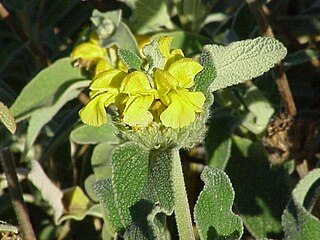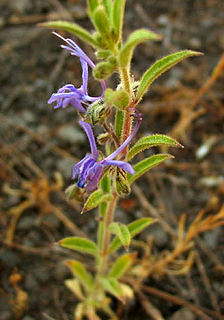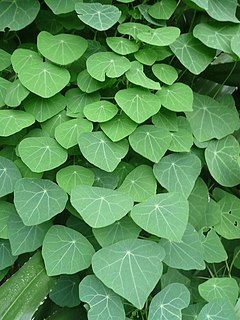
Kathmandu officially the Kathmandu Metropolitan City, is the capital and the most populous city of Nepal with 845,767 inhabitants living in 105,649 households in 2021 and 2.9 million people in its urban agglomeration. It is located in the Kathmandu Valley, a large valley in the high plateaus in central Nepal, at an altitude of 1,400 metres.

The Lamiaceae or Labiatae are a family of flowering plants commonly known as the mint or deadnettle or sage family. Many of the plants are aromatic in all parts and include widely used culinary herbs like basil, mint, rosemary, sage, savory, marjoram, oregano, hyssop, thyme, lavender, and perilla, as well as other medicinal herbs such as catnip, salvia, bee balm, wild dagga, and oriental motherwort. Some species are shrubs, trees, or, rarely, vines. Many members of the family are widely cultivated, not only for their aromatic qualities, but also their ease of cultivation, since they are readily propagated by stem cuttings. Besides those grown for their edible leaves, some are grown for decorative foliage. Others are grown for seed, such as Salvia hispanica (chia), or for their edible tubers, such as Plectranthus edulis, Plectranthus esculentus, Plectranthus rotundifolius, and Stachys affinis. Many are also grown ornamentally, notably coleus, Plectranthus, and many Salvia species and hybrids.

Mount Everest is Earth's highest mountain above sea level, located in the Mahalangur Himal sub-range of the Himalayas. The China–Nepal border runs across its summit point. Its elevation of 8,848.86 m (29,031.7 ft) was most recently established in 2020 by the Chinese and Nepali authorities.

Nepal, officially the Federal Democratic Republic of Nepal, is a landlocked country in South Asia. It is mainly situated in the Himalayas, but also includes parts of the Indo-Gangetic Plain, bordering Tibet of China to the north, and India in the south, east, and west, while it is narrowly separated from Bangladesh by the Siliguri Corridor, and from Bhutan by the Indian state of Sikkim. Nepal has a diverse geography, including fertile plains, subalpine forested hills, and eight of the world's ten tallest mountains, including Mount Everest, the highest point on Earth. Nepal is a multi-ethnic, multi-lingual, multi-religious and multi-cultural state, with Nepali as the official language. Kathmandu is the nation's capital and the largest city.

The Nepalese Civil War was a protracted armed conflict that took place in the former Kingdom of Nepal from 1996 to 2006. It saw fighting between the Nepalese royal government and the Communist Party of Nepal (Maoist) throughout the country. The war was the decisive factor that led to the collapse of the Nepalese kingdom in 2008 and the subsequent establishment of the present-day Federal Democratic Republic of Nepal.

Verbascum is a genus of over 450 species of flowering plants, common name mullein, in the figwort family Scrophulariaceae. They are native to Europe and Asia, with the highest species diversity in the Mediterranean.

Stachys is one of the largest genera in the flowering plant family Lamiaceae. Estimates of the number of species in the genus vary from about 300, to about 450. The type species for the genus is Stachys sylvatica. Stachys is in the subfamily Lamioideae. Generic limits and relationships in this subfamily are poorly known.

Phlomis is a genus of over 100 species of herbaceous plants, subshrubs and shrubs in the family Lamiaceae, native from the Mediterranean region east across central Asia to China.

Myrica is a genus of about 35–50 species of small trees and shrubs in the family Myricaceae, order Fagales. The genus has a wide distribution, including Africa, Asia, Europe, North America and South America, and missing only from Australia. Some botanists split the genus into two genera on the basis of the catkin and fruit structure, restricting Myrica to a few species, and treating the others in Morella.

Manang District (Nepali: मनाङ जिल्लाListen , a part of Gandaki Province, is one of the seventy-seven districts of Nepal. The district, with Chame as its district headquarters, covers an area of 2,246 km2 and had a population of 6,538.

Bauhinia variegata is a species of flowering plant in the legume family, Fabaceae. It is native to an area from China through Southeast Asia to the Indian subcontinent. Common names include orchid tree and mountain ebony.

Trichostema lanceolatum, with the common names vinegarweed and camphor weed, is an annual flowering herb of the mint family native to western North America.

Stephania is a genus of flowering plants in the family Menispermaceae, native to eastern and southern Asia and Australia. They are herbaceous perennial vines growing to around four metres tall, with a large, woody caudex. The leaves are arranged spirally on the stem, and are peltate, with the leaf petiole attached near the centre of the leaf. The name Stephania comes from the Greek, "a crown". This refers to the anthers being arranged in a crown like manner.

Commelina benghalensis, commonly known as the Benghal dayflower, tropical spiderwort, or wandering Jew, kanshira in Bengali, is a perennial herb native to tropical Asia and Africa. It has been widely introduced to areas outside its native range, including to the neotropics, Hawaii, the West Indies and to both coasts of North America. It has a long flowering period, from spring to fall in subtropical areas, and throughout the year closer to the equator. It is often associated with disturbed soils.

Thysanolaena is a genus of plants in the grass family, the only genus in the tribe Thysanolaeneae. Its only recognized species is Thysanolaena latifolia, native to Bangladesh, Bhutan, Cambodia, China, India, Indonesia, Laos, Malaysia, Myanmar, Nepal, New Guinea, Philippines, Sri Lanka, Taiwan, Thailand, and Vietnam. It is also naturalized in Mauritius, Seychelles, Gambia, Tanzania, Hawaii, California, the West Indies and Brazil. Tiger grass, Nepalese broom grass, broom grass, broom stick are common names for this plant, in Nepali amliso and jharu in Assamese. The flowers of this plant are used as cleaning tool or broom, which is known as कुच्चोkuchcho in Nepali, झाड़ू jhadu in Hindi.

Millettia pachycarpa is a perennial climbing shrub belonging to the genus Millettia. It is one of the most well known among ~150 species of Millettia, as it is widely used in traditional practices, such as for poisoning fish, agricultural pesticide, blood tonic, and treatments of cancer and infertility. The bark fiber is used for making strong ropes.

Rubus ellipticus, commonly known as ainselu, golden evergreen raspberry, golden Himalayan raspberry, or yellow Himalayan raspberry, is an Asian species of thorny fruiting shrub in the rose family. It is native to China, Nepal, India, Pakistan, Indochina, and the Philippines.

Zanthoxylum armatum, also called winged prickly ash or rattan pepper in English, is a species of plant in the family Rutaceae. It is an aromatic, deciduous, spiny shrub growing to 3.5 metres (11 ft) in height, endemic from Pakistan across to Southeast Asia and up to Korea and Japan. It is one of the sources of the spice Sichuan pepper, and also used in folk medicine, essential oil production and as an ornamental garden plant.

Phlomoides, also called Jerusalem sage and Lampwick plant, is a genus of over 130 species of flowering plants in the family Lamiaceae, native from the Mediterranean region east across central Asia to China. Phlomoides now comprises the former Notochaete hamosa, many former species of the genera Phlomis and Eremostachys and all of Lamiophlomis and Pseuderemostachys.
Barry John Conn, is an Australian botanist. He was awarded a Ph.D. from Adelaide University in 1982 for work on Prostanthera.


















